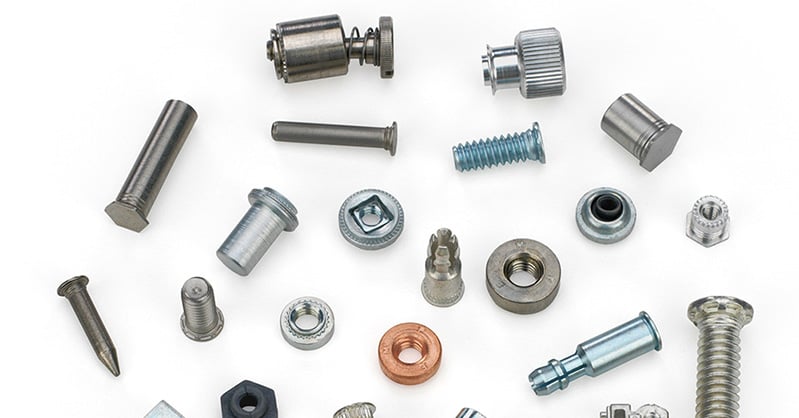Self-clinching fasteners were created some 70 years ago. Today there are a multitude of types and variations of self-clinching fasteners that serve a variety of purposes.
Standard types include studs, nuts, spacers, access hardware, panel-mounting hardware, hooks, and cable-tie mounts. Generally speaking, self-clinching fasteners are permanently installed by pressing them into thin metal sheets, causing the displaced metal to cold flow into the pilot in the fastener, locking it in place.
Self-clinching fasteners must be able to withstand hard tugs and heavy torque loads. They can be installed mid- or post-fabrication and offer a variety of benefits, including durability and the use of less hardware.
Let’s take a look at the different standard self-clinching fasteners that make up the standard types found in the market and some installation tips to help you get familiar with a product that has many variations and use cases.
Studs
These fasteners are used when components need to be installed before final attachment. Studs are externally threaded and come in different types, including flush head and other variations for high torque, thin sheet and electrical. Self-clinching studs have a wide range of thread styles, including those without threads for use as guide pins or pivots.
Nuts
When you need strong load-bearing threads, nuts are the way to go. The clinching action of these nuts takes place on the fastener side of the metal, leaving the reverse side smooth and flush. Nuts can vary in size and material; a mating screw typically finishes out the fastening job.
Spacers (Standoffs)
Used primarily to stack or space components, spacers or standoffs come in both thru-threaded and blind threaded versions. Spacer heads are always flush with the sheet post-installation. Concealed head types leave surfaces smooth and closed. Snap-top standoffs are used with circuit boards and snap for easier assembly and disassembly.
Access Hardware
With captive screws that minimize loose components and mitigate the risk of hardware that gets loose or damaged, or falls out of the setup, self-clinching fasteners are ideal for access hardware use.
Panel Mounting Hardware
Key-lock fasteners are used to connect two sheets of metal while keeping each side flush and smooth. They can join two metal sheets while allowing one sheet to be removed from the other by sliding the top sheet sideways. These self-clinching fasteners can also be used as pivot points, since they rotate.
Hooks and Cable Tie Mounts
These fasteners are used to attach wires and cables to electronic enclosures without the use of adhesives or screws. For components that need to be replaced or serviced, hooks can be used to bundle wires at mounting points.
Things to Remember When Installing Self-Clinching Fasteners
Self-clinching fasteners, as their name suggests, do not require you to purchase any major installation equipment for smaller components; a Pemserter Micro-Mate hand tool is all you will need. Remember the following when installing the self-clinching fastener of choice:
- Even if both the panel and fastener are of like materials, the panel must always be more malleable than the fastener, otherwise cold flow can’t occur to lock the fastener in place
- A panel's minimum thickness is imperative to accommodate a specific fastener
- Avoid using blunt force like hitting the fastener with a hammer, as the speed of the fastener entering the pilot will be too fast for cold flow to properly take place
- Make sure you purchase high-quality self-clinching fasteners to align with your needs; quality fasteners require precise production methods and best practices, as even the tiniest discrepancies in production can cause major problems down the road
Benefits of Self-Clinching Fasteners
There are many benefits of using self-clinching fasteners, but here are the most important, top-level benefits to their correct use:
- Self-clinching fasteners reduce the number of components required to complete assembly
- Self-clinching fasteners eliminate steps in the process of final assembly
- They reduce the total assembly time via the reduction in the number of components needed
- Self-clinching fasteners shorten the time it takes to get your products to market
- They improve quality control and reduce error via process simplification
- Self-clinching fasteners also reduce costs since they reduce the cost of components (since there are fewer needed) and labor (since the number of steps for completion are reduced)
The HTF team is ready to help you in any way you need.
We have a wide array of high-quality, precision-made self-clinching fasteners available that can meet any need and function. And we can deliver them faster than anyone else in the market.
We take great pride in being able to deliver what you need, when you need it, along with the best and most attentive customer service in the industry. That’s why we have long-standing, trust-based relationships with the top manufacturers in the industry.
Reach out to us today. We’re ready to help.





.png?width=800&name=InventoryXpert-Blog-Alt%20(5).png)



